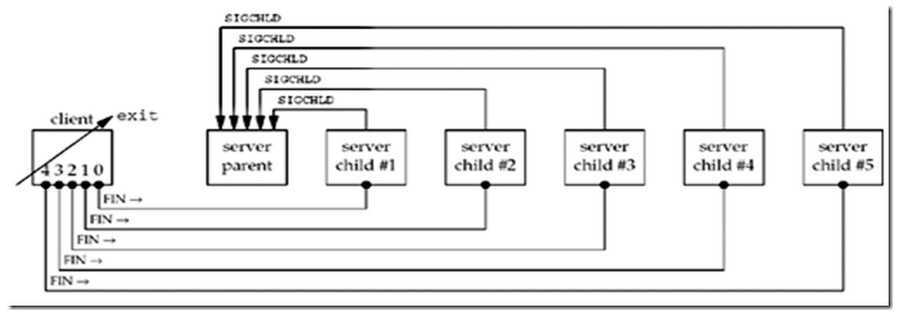标签:des style blog http io color ar os 使用
#include <stdlib.h> #include <stdio.h> #include <errno.h> #include <string.h> #include <unistd.h> #include <sys/socket.h> #include <netinet/in.h> #include <sys/types.h> #include <netdb.h> #define SERV_PORT 1113 #define LISTENQ 32 #define MAXLINE 1024 /***连接处理函数***/ void str_echo(int fd); void sig_chld(int signo) { pid_t pid; int stat; pid = wait(&stat);//获取子进程进程号 printf("child %d terminated\n", pid); return; } int main(int argc, char *argv[]){ int listenfd,connfd; pid_t childpid; socklen_t clilen; struct sockaddr_in servaddr; struct sockaddr_in cliaddr; //struct sockaddr_in servaddr; //struct sockaddr_in cliaddr; if((listenfd = socket(AF_INET, SOCK_STREAM,0))==-1){ fprintf(stderr,"Socket error:%s\n\a",strerror(errno)); exit(1); } /* 服务器端填充 sockaddr结构*/ bzero(&servaddr, sizeof(servaddr)); servaddr.sin_family = AF_INET; servaddr.sin_addr.s_addr = htonl (INADDR_ANY); servaddr.sin_port = htons(SERV_PORT); signal(SIGCHLD,sig_chld);//处理SIGCHLD信号 /* 捆绑listenfd描述符 */ if(bind(listenfd,(struct sockaddr*)(&servaddr),sizeof(struct sockaddr))==-1){ fprintf(stderr,"Bind error:%s\n\a",strerror(errno)); exit(1); } /* 监听listenfd描述符*/ if(listen(listenfd,5)==-1){ fprintf(stderr,"Listen error:%s\n\a",strerror(errno)); exit(1); } for ( ; ; ) { clilen = sizeof(cliaddr); /* 服务器阻塞,直到客户程序建立连接 */ if((connfd=accept(listenfd,(struct sockaddr*)(&cliaddr),&clilen))<0){ /*当一个子进程终止时,执行信号处理函数sig_chld, 而该函数返回时,accept系统调用可能返回一个EINTR错误, 有些内核会自动重启被中断的系统调用,为便于移植,将考虑对EINTR的处理*/ if(errno==EINTR) continue; fprintf(stderr,"Accept error:%s\n\a",strerror(errno)); exit(1); } //有客户端建立了连接后 if ( (childpid = fork()) == 0) { /*子进程*/ close(listenfd); /* 关闭监听套接字*/ str_echo(connfd); /*处理该客户端的请求*/ exit (0); } close(connfd);/*父进程关闭连接套接字,继续等待其他连接的到来*/ } } void str_echo(int sockfd){ ssize_t n; char buf[MAXLINE]; again: while ( (n = read(sockfd, buf, MAXLINE)) > 0) write(sockfd, buf, n); if (n < 0 && errno == EINTR)//被中断,重入 goto again; else if (n < 0){//出错 fprintf(stderr,"read error:%s\n\a",strerror(errno)); exit(1); } } 修改代码后,当客户端断开连接后,服务器端父进程收到子进程的SIGCHLD信号后,会执行sig_chld函数,对子进程进行了清理,便不会再出现僵尸进程。此时,一个客户端主动断开连接后,服务器端会输出类似如下信息: child 12306 terminated wait和waitpid 上述程序中sig_chld函数,我们使用了wait()来清除终止的子进程。还有一个类似的函数wait_pid。我们先来看看这两个函数原型: pid_t wait(int *status); pid_t waitpid(pid_t pid, int *status, int options); 官方描述:All of these system calls are used to wait for state changes in a child of the calling process, and obtain information about the child whose state has changed. A state change is considered to be: the child ter minated; the child was stopped by a signal; or the child was resumed by a signal. In the case of a terminated child, performing a wait allows the system to release the resources associated with the child; if a wait is not performed, then the terminated child remains in a "zombie" state (see NOTES below). 关于wait和waitpid两者的区别与联系: The wait() system call suspends execution of the calling process until one of its children terminates. The call wait(&status) is equivalent to: waitpid(-1, &status, 0); The waitpid() system call suspends execution of the calling process until a child specified by pid argument has changed state. By default, waitpid() waits only for terminated children, but this behavior is modifiable via the options argument, as described below. 也就是说,wait()系统调用会挂起调用进程,直到它的任意一个子进程终止。调用wait(&status)的效果跟调用waitpid(-1, &status, 0)的效果是一样一样的。 waitpid()会挂起调用进程,直到参数pid指定的进程状态改变,默认情况下,waitpid() 只等待子进程的终止状态。如果需要,可以通过设置options的值,来处理非终止状态的情况。比如: The value of options is an OR of zero or more of the following constants: WNOHANG return immediately if no child has exited. WUNTRACED also return if a child has stopped (but not traced via ptrace(2)). Status for traced children which have stopped is provided even if this option is not specified. WCONTINUED (since Linux 2.6.10)also return if a stopped child has been resumed by delivery of SIGCONT. 等等一下非终止状态。 现在来通过实例看看wait()和waitpid()的区别。 通过修改客户端程序,在客户端程序中一次性建立5个套接字连接到服务器,状态如下图所示(附代码):
当客户终止时,所以打开的描述子均由内核自动关闭,因此5个连接基本在同一时刻发生,相当于同时引发了5个FIN发往服务器,这会导致5个服务器子进程基本在同一时刻终止,从而导致5个SIGCHLD信号几乎同时递送给服务器父进程,示意图如下所示:

也就是说,几乎在同一时刻,递送5个SIGCHLD信号给父进程,这又会僵尸进程进程的出现。因为unix一般不对信号进行排队,这就导致了5个SIGCHLD递交上去,只执行了一次sig_chld函数,剩下四个子进程便成为了僵尸进程。对于这种情况,正确的做法是调用waitpid(),而不是wait()。
因此,我们最后的服务器端代码中的信号处理函数做一点小改动,改成如下:
至此,我们解决了网络编程中可能遇到的三类情况:
1.当派生子进程时,必须捕获SIGCHLD信号。代码片段:signal(SIGCHLD,sig_chld);
2.当捕获信号时,必须处理被中断的系统调用。代码片段:if(errno==EINTR)
continue;
3.SIGCHLD信号处理函数必须编写正确,以防出现僵尸进程。代码片段:while ( (pid = waitpid(-1,
&stat, WNOHANG)) > 0)
http://www.jb51.net/LINUXjishu/113671.html
标签:des style blog http io color ar os 使用
原文地址:http://www.cnblogs.com/leijiangtao/p/4097344.html